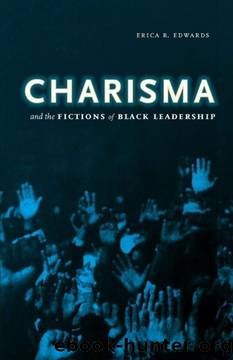Charisma and the Fictions of Black Leadership (Difference Incorporated) by Erica R. Edwards

Author:Erica R. Edwards [Edwards, Erica R.]
Language: eng
Format: epub
Published: 2012-05-04T07:37:00+00:00
When a man races to the porch later, frantically-"as though being chased by ghosts or a thousand angry Negroes"-with news of Tucker's salting his field, the men rush from the porch to Tucker's farm for an even better view of what is quickly becoming a nonspectacle of Tucker's not-so-public intentions; in a sense, it is a spectacle that refuses spectacle (36).
The townsfolk, white and black, "gape as at a Confederate Day Parade" and gaze "mesmerized at Mister Harper," who has begun walking, after thirty years of sitting in a wheelchair, to lead the parade of puzzled onlookers (38). Here the reader sees Tucker for the first time, and the narrative offers a full view of its protagonist before disappearing him in the pages that follow. The reader, and the novel's characters, watch a "boy-sized" Tucker at work:
Across the field Harry could see him, one small speck of a white shirt; he wore black pants and was himself black and barely discernible against the darkness of the trees enclosing the farm. Harry watched as Tucker ran out of salt and came slowly toward the house and mound, stepping high over the furrows. Then he was close by, his head lowered, and Harry could see the small features seeming lost on the large head, the steel-rimmed spectacles on his flat nose. If he had gone insane, was running wild ... he did not show it. (41)
The salting scene spans three unassuming pages as Tucker makes "trip after trip," literally at the vanishing point of Harry's visual frame, to the salt mound in "the silence of the late afternoon" (41). Here the reader apprehends Tucker's leadership as silent, deliberate labor, not as spectacle. Indeed, as David Bradley suggests, Tucker's leadership in the novel differs significantly from the civil rights spectacles that, by the time of the novel's publication, had become staple media fodder: "In 1962 blacks were not only protesting but protesting loudly; speeches and singing were as much a hallmark of mass marches as was marching itself. But Tucker makes no soundmakes not even a public statement.""s
The only explanation that the novel offers of Tucker's motivations is in fact packaged in a violent interruption of ordered speech. After Tucker's grandfather, John Caliban, dies on the literal color line, Tucker objects to his postmortem characterization as docile in the face of white supremacy. When the elder Caliban dies, the Willsons accompany Tucker and Bethrah to pick him up at the bus station where he lay. They notice the pearl-colored [chauffeur's] hat in his lap, the round patch of bristling white hair leaning heavily on the chrome-plated cross bar that separated the back of the bus from the front" (121). Afterward, John is remembered as the stereotypical Uncle Tom who consented to the Jim Crow regime happily, spiritedly: Dewey "could only remember him singing and laughing" (121); the eulogist remarks, "We'll all remember John because when he come into our lives he was always smiling and happy and made us feel good just to
Download
This site does not store any files on its server. We only index and link to content provided by other sites. Please contact the content providers to delete copyright contents if any and email us, we'll remove relevant links or contents immediately.
| Anthropology | Archaeology |
| Philosophy | Politics & Government |
| Social Sciences | Sociology |
| Women's Studies |
The Leavers by Lisa Ko(6474)
Born to Run: by Christopher McDougall(6262)
iGen by Jean M. Twenge(4702)
Sapiens by Yuval Noah Harari(4537)
The Kite Runner by Khaled Hosseini(4436)
Spare by Prince Harry The Duke of Sussex(4199)
Bullshit Jobs by David Graeber(3180)
Livewired by David Eagleman(3123)
Goodbye Paradise(2964)
Never by Ken Follett(2882)
A Dictionary of Sociology by Unknown(2518)
Harry Potter 4 - Harry Potter and The Goblet of Fire by J.K.Rowling(2416)
The Club by A.L. Brooks(2360)
People of the Earth: An Introduction to World Prehistory by Dr. Brian Fagan & Nadia Durrani(2346)
The Social Psychology of Inequality by Unknown(2311)
Machine Learning at Scale with H2O by Gregory Keys | David Whiting(2292)
Harry Potter and the Order of the Phoenix (5) by J.K. Rowling(2227)
0041152001443424520 .pdf by Unknown(2220)
Don't Sleep, There Are Snakes by Daniel L. Everett(2217)
